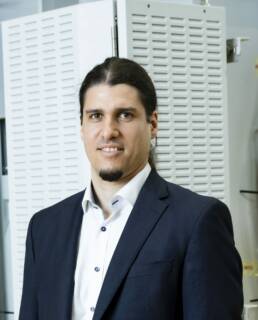The rotating machine sector also reached the digital age: Ganz launches intelligent electric rotating machines
In 2022, Ganz Transformers and Electric Rotating Machines Ltd. introduced Intelligent Solutions, a digital condition monitoring system for power transformers. At the same time and in response to the increased market demand, the heavy machinery manufacturer has decided to extend its intelligent solution to other products in its portfolio, including electric rotating machines. By spring 2023, Ganz successfully developed and will soon produce the first intelligent rotating machine equipped with the digital condition monitoring system. In their interview, Gábor Farkas, Brand Manager of Intelligent Solutions and Bence Flösser, Head of the Engineering Office of Ganz’s Rotating Machine Division spoke about the development process conducted over the past year, the digitalization of electric rotating machines with a life span of up to 30-40 years, the monitoring service offered by the company as well as Ganz’s short and long-term plans for digitalization.
When did the development of the intelligent monitoring system for electric rotating machines start and would you tell us about the process involved?
Bence Flösser: In parallel with the development process of the intelligent transformer, the idea arose that the technology of the condition monitoring system should be transferred and extended to Ganz’s other business unit and apply to the electric rotating machines. Subsequently, the past year has been characterised by a search for the direction in which to take the development of this system. This process, which lasted until December 2022, included a survey, a kind of market research, which showed us that there is a real need and demand (based on our customers’ feedback) for intelligent condition monitoring system also on the market of electric machines. Then, we got a significant boost in product development when Gábor Farkas joined us as brand manager at the beginning of this year. He was the one who helped us to put the product on the market in a well-established and defined framework.
All in all, we can say that this development process started about a year ago, and as a result, the first electric rotating machine with an intelligent monitoring system will be produced in a few weeks at Ganz’s factory in Tápiószele.
Why do you think intelligent condition monitoring is also relevant in the case of rotating machines?
Bence Flösser: On average, electric rotating machines used in heavy and energy industries can reach an operating life of 30-40 years. However, the level of reliability at which the equipment is operated during its lifetime is also an important factor. Condition-based maintenance has therefore become an important part of the maintenance strategy, allowing us to monitor not only the uptime of the machine and its components, but also the degree of deterioration of a unit that has been in operation for, let’s say, 25 000 hours. As such, condition monitoring systems use sensors to enable us to have real-time information about the health status of the electrical machine.
When it comes to the smooth operation of rotating machines, proper insulation or the optimal functioning of bearings is a critical aspect, as the failure of these components and systems can have serious consequences, even resulting in the need to replace the equipment and invest in a completely new unit.

Bence Flösser – Head of Rotating Machines Engineering
Gábor Farkas: The use of condition monitoring systems, on the other hand, helps us to avoid system-level operational losses associated with more serious failures and allows us data-driven decision-making regarding the servicing and refurbishment of these units. This allows us not only preventive maintenance, but also cost efficiency and prolonging the lifetime of the unit.

Gábor Farkas – Brand manager
Based on Ganz’s survey and market research, how much demand is there in the market for this type of digitalized solution?
BF: I think that digitalization in the rotating machine industry is still in its very early days. A proof that we are at the very beginning of this journey is that only the biggest, leading international players in the industry have offered digitalisation packages to their customers so far.
However, based on the results of the survey conducted by Ganz and the feedback we received from our customers we have seen that there is a significant demand for intelligent rotating machines in the market. It is confirmed that the condition monitoring system is a useful service for many of our customers. However, the development of the system, which currently is mainly used for larger and more expensive machines, has not yet reached the point where it can be applied more widely to smaller electrical machines as well.
GF: In addition, by developing Intelligent Solutions and transformer units equipped with the monitoring system, we have gained knowledge and experience that we can apply to rotating machines, and Ganz can play a pioneering role on the market.
When is the first intelligent rotating machine of Ganz expected to be produced?
GF: As previously mentioned by Bence, the pilot developments have recently been successfully completed, and the test runs of the first intelligent unit will also start in a few weeks. The results so far are very encouraging. So, the first full construction is expected to be completed in the second quarter of this year. We have no doubts about the viability and applicability of the condition monitoring system, thus the integration of the intelligent rotating machine into Ganz’s portfolio has already begun.
Can you tell us about how the intelligent monitoring system of the electrical rotating machines work? And what packages will be available as part of the service offered by Ganz?
BF: The condition monitoring system is in fact a digitalization unit mounted on the stator housing of the rotating machine. A centralised data processing and interface unit collects the signals from the various sensors mounted on the machines and provides access to the condition monitoring functions. For rotating machines, similarly to intelligent transformers, we will offer our customers three packages.
GF: It is also important to highlight the key features of the interface. Not only does the system allow data to be displayed, but alarms can also be set for each parameter as required and the same is available for trend monitoring. As for the packages, in addition to the standard digitization solutions developed in advance, there is also the possibility to offer a customised solution – tailor-made to the client’s needs. Any external, third-party condition monitoring device can also be easily integrated and deployed in the system. Or we can configure our condition monitoring system to measure specifically requested parameters.
More specifically, what are the characteristics of intelligent condition monitoring systems on electric rotating machines?
BF: Given that, as in the case of intelligent transformers, the motors and generators are also electrical machines, the operating principle of the system is like that of transformers and there is an overlap between the two. Typically, this digital system also allows us to monitor mainly electrical and thermal values. In addition, since we are talking about a rotating machine, certain mechanical status indicators can also carry important information. In addition, the monitoring system provides data on vibration and rotation speed, can display the current and voltage signature of the unit, and can also monitor partial discharge conditions.
What would you mention as Ganz’s short and long-term goals in this area?
GF: Our short-term goal is to validate the functionality of the condition monitoring system by completing the pilot project and manufacturing Ganz’s first intelligent rotating machine. In the long term, we want to develop an expert system with a fleet management service that will allow us to monitor the status of several units at the same time.
Looking at the bigger picture, the broader spectrum of the rotating machines market, our aim is to promote the widespread adoption of condition monitoring systems. Sustainability, reducing carbon-emissions and the ecological footprint, or ensuring the availability of electrical machines, is not just a passing trend in the market, it is a necessity. A direction that all market players will have to take sooner or later.
With the launch of Intelligent Solutions in 2022, Ganz has set a goal to be a pioneer in digital monitoring systems. And we want to extend this engagement to the rotating machines sector: we aim to guide and educate the operators about the importance of digitalization and the long-term benefits it brings to this area.
BF: The information that flows back from the monitoring system also greatly facilitates the work of the engineering office. With this data gathered, the further development of the equipment, the electric rotating machine, can be made much more efficient. Thus, we can say that condition monitoring systems speed up the optimization and technological development of electrical machines, since the manufacturer may have access to information that can be only gathered during operating conditions. As a result, we will be able to develop, design and manufacture machines of even better construction. This will also enable Ganz to provide a service of higher quality based on professional expertise.
How can the intelligent rotating machines contribute to the green turn of the energy industry and to sustainability goals?
GF: Similarly to transformers, sudden failures and unexpected disconnections in this area can also have serious costs and even unforeseen consequences. Intelligent systems can take the fleet’s reliability and availability to a new level. Predicting the onset of critical failures is also a way to extend the lifetime of these machines. With a continuous online connection to the machine and the ability to monitor its critical parameters in real time, we can also achieve the most optimal solutions when scheduling maintenance.
Thanks to these benefits, the operational costs and the cost of guaranteeing the availability will be reduced significantly, which will contribute to reducing global carbon emissions.

